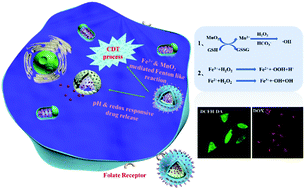Tumor microenvironment responsive mesoporous silica nanoparticles for dual delivery of doxorubicin and chemodynamic therapy (CDT) agent†
Abstract
Chemodynamic therapy is a new antitumor strategy triggered by transition metal as chemodynamic agent via the in situ catalytic Fenton reaction. Herein, we engineer a smart nanocarrier activated by tumor microenvironment-specific weak acidic pH and high glutathione conditions for chemo/chemodynamic processes. This unique architecture orderly consists of mesosilica-encapsulated doxorubicin, self-polymerization of polydopamine Fe3+ clathrate, further bonding the targeting polymer MnO2 disguised albumin–folic acid. Polydopamine and albumin as intelligent nanovalves shield doxorubicin from premature leaking. Folic acid improves the targeting capability for folate receptor (FR) overexpressing cancer cells. After intake of the nanocarrier by tumor cells, the nanocarrier nanovalves are first biodegraded by native glutathione and pH, enabling on-demand anticancer drug escape, and also generate and release Fe3+ and Mn2+ (reduced by MnO2via glutathione depletion). Subsequently, the ions interact with H2O2, generating highly toxic hydroxyl radicals (˙OH) via a Fenton-like reaction to enhance the anticancer cell efficacy. This result proves that the designed nanocarrier more likely devours into FR-positive cancer cells and illustrates a high intracellular ˙OH generation, leading to the desired specific killing efficacy. We believe this innovative strategy will exhibit a new avenue for the potential of accurate chemo/chemodynamic co-therapy in cancer cells.



 Please wait while we load your content...
Please wait while we load your content...